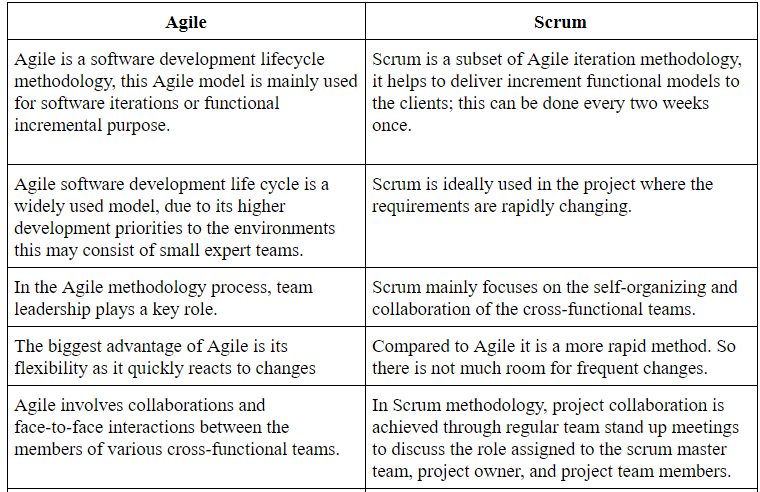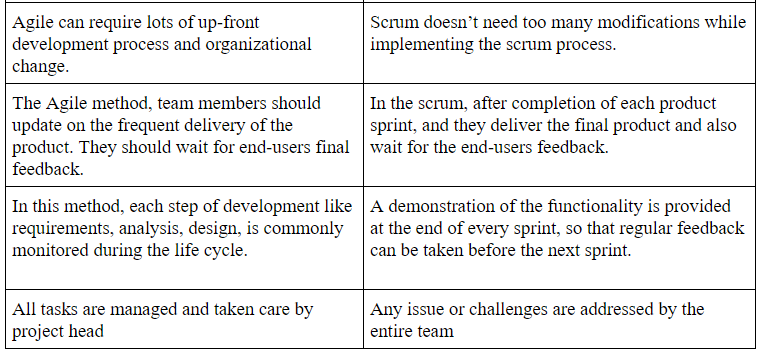What is Agile?
Agile is nothing but one of the software development methodologies that approaches the development requirements and solutions. This can be performed through the collaboration of self-organizing, cross-platform usage, and also with their customers or end-users.Agile software was developed in the year February 17th, 2001 at the Utah software developers’ conference. Firstly they called it "Manifesto for Agile software developments' ' now we call it as Agile methodology.They have come up with 12 main principles of Agile, to support cross-functional iterations. The main purpose to use Agile in the software development life cycle is to support adaptive business planning, evolutionary product developments, iterative approach towards the software, encouraging the team to perform flexible changes, and delivery.
What is Scrum?
Scrum is nothing but an agile framework used in the developments, delivery, and sustainable complex software products. This model also offers initial emphasis for the software development lifecycle, and also the Scrum model has been used in many applications such as research, sales and marketing, and also advanced business technologies. In simple terms, it can be defined as a subset of the Agile model and the most widely used process framework.
The Scrum was first introduced by Jeff Sutherland and Ken Schwaber in the early 2000s.
Become an Agile Certified professional by learning Agile Online Training from hkrtrainings!

Agile Online Training
- Master Your Craft
- Lifetime LMS & Faculty Access
- 24/7 online expert support
- Real-world & Project-Based Learning
Differences between Agile and Scrum
In this section, I am going to explain the major differences between Scrum and Agile methodologies,

Table to be continued

Table to be continued

We have the perfect professional Scrum Master Training Online for you. Enroll now!
Agile Methodology in detail
Agile methodology in general uses the short project development lifecycle to produce continually integrated into software development. This methodological approach is mainly focused on delivering iterative and incremental services throughout the project development life cycle. Agile methodology reduces the risk in the project plan, requirement building, execution of the product, testing the product by breaking the big cycle into smaller segments. Then these small segments or the final product will be specified, developed, and testable in the maximum three-four weekly cycle.
There are 5 types of Agile methodology process available:
1. Evaluation of the process and current structure of the organizations:
This Agile methodology supports the mapping processes to determine the starting point and the actual state.
2. Process optimization and suggestion for improvements:
Helps to optimize the processes with the right combination of the technologies
3. Helps in the designing of applications with the client:
We choose the technologies and review options with the client. The client is a part of the project from the very beginning and feedback is vital.
4. Application constructions and implementations:
Enables weekly delivery of developments for the end-users to operate and request for change. It is IDEAL that the user is a part of the process of development and testing.
5. Evaluation and Monitoring:
These determine the KPI's, reports, and other matrices, per user. To monitor that the processing is working as agreed.
Principles of Agile methodology
12 primary principles in Agile methodology explain there are 12 primary principles in Agile methodology that explain the overall working structure of the software development lifecycle.
1. Agile always focuses on customer satisfaction, that's the highest priority and it can be achieved through faster and continuity in the product delivery.
2. This enables users to change the project environment at any stage of the lifecycle process to offer the clients with standard advantages.
3. With the help of Agile methodology, any type of product or service can be delivered with higher frequencies.
4. Agile methodology helps the stakeholders and business developers to collaborate closely on a daily work basis.
5. The company's team members and all the stakeholders will be motivated continuously for the optimal project or service outcome, while the company's team members are provided with all the necessary fundamental tools and encouragement to work towards the final project goals/outcome.
6. Face-to-face meetings are considered to be the most efficient and effective source for any project success.
7. A final working service/product will be the ultimate measure of project success.
8. The sustainable development environment will be available through the agile methodology process, thereby development team members and stakeholders will be able to maintain an ongoing pace and constant outcomes.
9. Agility is possible through the continuous focus on software technical excellence and proper project planning.
10. Simplicity is an essential part of the software development lifecycle.
11. This makes self-organizing business teams develop the best project architecture and designs ever.
12. Regular time intervals are used by the company's team members to improve efficiency and optimization.
Advantages of Agile
There are a lot of advantages that make Agile the most popular model nowadays. I would like to mention a few primary advantages of Agile model:
1. Offers better product quality: testing is integrated into the software life cycle with regular checkups and enabling product changes if they needed it.
2. Customer satisfaction is the highest priority:
The software product is involved in the process and this makes the customer part of the project.
3. Provides more control on the project:
This offers more transparency in the development and designs, short customer meetings, visibility of every step of the project during the development life cycle.
4. Risk reduction:
The risk of total failure and elimination as there is a constant contract.There is the freedom to add new changes throughout the process and adapting them to client preferences.
5. Faster Return on Interest (ROI):
With the use of Agile iteration, the features will be delivered soon, developers will be having benefits from the beginning to the complete project outcome.

Subscribe to our YouTube channel to get new updates..!
Disadvantages of Agile
Even with a lot of advantages of Agile methodology, there are also few drawbacks of Agile models. Let me mention a few points;
1. Longer length in each iteration or increment.
2. Cannot accommodate changes anytime.
3. Lack of user involvement throughout the life cycle of the product.
4. Costly for dynamic development environments.
5. Assume that future changes will not occur.
SCRUM:
Scrum methodology in detail:
The Scrum methodology is nothing but the overall process of the model, which explains the task or operations performed by the model.
Steps are as follows:
- First, it will take the input from the customers, executives, team members, and stakeholders. The input data will then be sent to the respective product owner.
- Product backlog: this contains information like features, stories, or product requirements.
- Sprint planning meeting: this is done by team members, the team selects starting sprint plans at the top as much as it can be committed to delivering the project plans to the customers at the end of the sprint.
- Product backlog refinement: this is nothing but task breakouts.
- These sprints backlog will be sent to Scrum master along with providing sprint end date team deliverable do not change.
- Using burndown/up charts every 24 hours, it handles the daily scrum meeting, sprint customer reviews, working increment, and sprint retrospective.
Advantages of Scrum methodology
There are lots of key factors, which make Scrum a popular iteration tool. I would like to mention the primary advantages:
- Scrum is a subset of an agile process that allows teams to focus on producing the highest business outcome in the shortest time.
- This allows developers or team members to check or inspect the working environments. (every two weeks – one month).
- The business sets the priorities. Our team self-manages to determine the best way to deliver the highest priority features.
- Every two weeks – one month anyone can see real working software and decide release as it is or continue to enhance for the other iterations.
- Scrum methodology enables projects where the business requirements documentation is hard to quantify to be successfully developed.
- Scrum is a lightly controllable and approachable incremental method; these benefits may help to insist on frequent or continuous updating of the work progress through regular team meetings.
Related Article, Agile Work Environmennt
Disadvantages of Scrum Methodology
Even with lots of advantages make Scrum in more demand, but few drawbacks also there, let me make a few points:
- It is hard to get a definite end date.
- Daily meetings with team or stakeholders can go too strict and frustrating too.
- Each task can be spread over several scrum sprints backlog.
- Every time you need to work with a big team and a big project are the challenges that you will face.
- The quality of the software product is hard to develop and implement.
- Sometimes it’s very difficult for the scrum master to plan, structure, and organize a project that lacks a clear definition.
- Frequent changes and frequent product delivery create uncertainty regarding the nature of the final product and these changes make everyone in the team involved in the redesigning of the project environment.
Conclusion :
In this blog, I have tried my level best to explain the two popular iteration methodologies, they are Agile and Scrum master. Agile helps in the iteration of the product and cross-functionalities incremental. Whereas scrum is a subset of agile methodologies widely used in team meetings and collaborations. I hope this article may help a few of you to learn and know the major differences between these two methodologies and also for Agile community forums.
Other Related Article:
About Author
As a Senior Writer for HKR Trainings, Sai Manikanth has a great understanding of today’s data-driven environment, which includes key aspects such as Business Intelligence and data management. He manages the task of creating great content in the areas of Digital Marketing, Content Management, Project Management & Methodologies, Product Lifecycle Management Tools. Connect with him on LinkedIn and Twitter.
Upcoming Agile Online Training Online classes
| Batch starts on 10th Jan 2026 |
|
||
| Batch starts on 14th Jan 2026 |
|
||
| Batch starts on 18th Jan 2026 |
|

